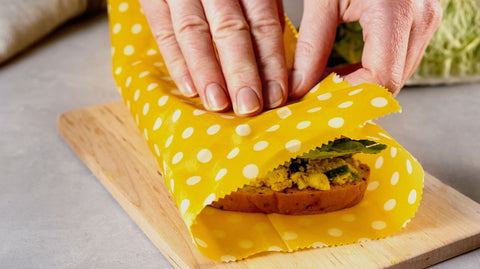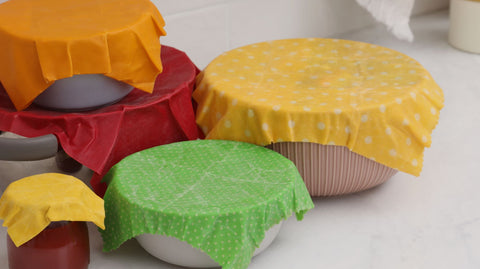Beeswax wrap is a reusable and sustainable alternative to plastic wrap and single-use plastic. It has the ability to counteract environmental issues such as plastic pollution and food waste. Beeswax wrap's main use is food preservation.
Plastic wrap may be convenient, but it's far from sustainable. As more people look for eco-friendly alternatives in their kitchens, beeswax wraps have emerged as a reusable and natural solution for food storage that is still extremely convenient.
Made from cotton infused with beeswax and other natural ingredients, these wraps are not only functional but also environmentally conscious. In this blog, we’ll explore the purpose of beeswax wraps, how they work, and why they’re worth considering as a simple switch toward a greener lifestyle.
What Are Beeswax Wraps?
Beeswax wraps are a natural alternative to plastic wrap, made from cotton fabric that has been coated with a blend of beeswax, tree resin, and jojoba oil. These materials combine to create a malleable, self-adhesive wrap that can be used to store food or cover containers. When warmed by the heat of your hands, the wrap softens and sticks to surfaces, creating a seal that helps keep food fresh.
Unlike cling film or foil, beeswax wraps are reusable and biodegradable. With proper care, beeswax wraps can last for up to a year, reducing both waste and the need for disposable alternatives.
The Purpose of Beeswax Wraps
The primary purpose of beeswax wraps is to reduce the use of single-use plastic products in the kitchen. With global awareness growing around plastic pollution and its environmental impact, many people are seeking sustainable ways to store food. Beeswax wraps provide a reusable option that can help minimize the amount of waste that ends up in landfills and oceans.
Beyond sustainability, beeswax wraps serve a practical function. They create a breathable seal that helps keep food fresh by allowing just enough airflow to prevent wilting while retaining moisture. This is especially helpful for preserving cut fruits, vegetables, bread, and cheese. Their versatility makes them a smart and eco-friendly staple in any household.
How to Use Beeswax Wraps
Using beeswax wraps is simple and intuitive. Just use the warmth of your hands to mold the wrap around a bowl, dish, or piece of food. Once the wrap cools slightly, it holds its shape and forms a seal. This makes it great for covering leftovers, wrapping sandwiches, or bundling snacks for on-the-go use. Many people also fold beeswax wraps into pouches to store nuts, berries, or cut veggies.
While beeswax wraps are incredibly versatile, they do have some limitations. They are not suitable for raw meat or hot food, as the heat can melt the wax or compromise food safety. It's best to use them for items that will be kept cool or at room temperature. With a little creativity, you’ll find plenty of ways to make them part of your daily routine.
Benefits of Beeswax Wraps
When you make the switch to beeswax wraps, you'll see just how convenient and accesible they are. Here's just a few benefits of making the switch to beeswax wraps:
- Eco-Friendly: Made from renewable resources and fully compostable at the end of their life.
- Cost-Effective: Reusable for up to a year, saving money over time compared to disposable wraps.
- Naturally Antibacterial: Beeswax and jojoba oil have properties that help inhibit mold and bacteria.
- Keeps Food Fresher: Breathable seal helps maintain freshness without trapping excess moisture.
- Stylish Designs: Available in a variety of patterns and colors to match your kitchen aesthetic.
- Simple Storage: Folds flat or rolls up for compact storage in your kitchen drawer.
How to Care for Your Beeswax Wraps
Caring for beeswax wraps properly ensures they last as long as possible. To clean, gently rinse them in cool water with a mild, alcohol-free soap. Avoid hot water, as it can melt the wax coating. After washing, let them air dry and store them flat or rolled in a drawer or basket.
Over time, you may notice creases or a slightly worn appearance, this is normal with regular use. If the wrap starts to lose its stickiness, you can refresh it by rewaxing or compost it at the end of its life. Proper care not only extends their usability but also helps maintain their food-safe, antibacterial properties.
Are Beeswax Wraps Worth It?
Yes! Many people find beeswax wraps to be a worthwhile investment, especially if they’re looking to reduce waste and make more sustainable choices in the kitchen.
Although the initial cost may be higher than plastic wrap, their reusability means you’ll save money in the long run. Plus, they add a touch of charm and intentionality to everyday food storage.
Beeswax wraps are particularly ideal for individuals or families pursuing a low-waste lifestyle, but even casual users can benefit. Whether you're packing lunches, covering leftovers, or wrapping produce from the farmer’s market, beeswax wraps offer a reusable, earth-friendly alternative.
For those looking to make small changes with a big impact, beeswax wraps are definitely worth considering.
Final Thoughts About Beeswax Wraps
Beeswax wraps offer a simple, sustainable solution to an everyday problem: food storage. They're reusable, biodegradable, and made from natural materials that help reduce our dependence on single-use plastics. Whether you're drawn to their environmental benefits, their stylish appeal, or their practicality, beeswax wraps are a smart addition to any eco-conscious kitchen.
If you're ready to make the switch, consider trying beeswax wraps from Ames Farm. Known for their high-quality honey and wax products, Ames Farm offers beautifully crafted beeswax wraps that make sustainable living easy, and even enjoyable. Small changes like this can have a lasting impact, both for your home and the planet.
Frequently Asked Questions About Beeswax Wraps
How do beeswax wraps help reduce plastic waste?
Beeswax wraps replace single-use plastic wrap, zip-top bags, and other disposable food storage products. Since they can be washed and reused for up to a year or longer, using beeswax wraps means significantly fewer plastic items being thrown away each week. By making this simple swap, households can help reduce plastic pollution, decrease landfill waste, and lessen their overall environmental impact. For eco-conscious consumers, beeswax wraps are a tangible way to live more sustainably.
Are beeswax wraps safe to use with all types of food?
Beeswax wraps are safe for wrapping most types of food, including fruits, vegetables, cheese, bread, and sandwiches. However, they are not recommended for raw meat or fish due to food safety concerns. The wraps cannot be washed in hot water without damaging the wax, which makes it difficult to sanitize them thoroughly after contact with raw animal products. For everything else, they are a reliable and safe alternative to plastic-based wraps.
How do I clean and store beeswax wraps?
leaning beeswax wraps is simple but must be done with care. Use cool water and a mild, alcohol-free soap to gently rinse the wrap. Hot water can melt the wax coating and damage the wrap, so it’s important to stick with cooler temperatures. After washing, hang or lay the wrap flat to air dry. Once dry, store the wraps in a drawer, a clean basket, or rolled up in a jar, whatever keeps them flat and away from heat sources.


